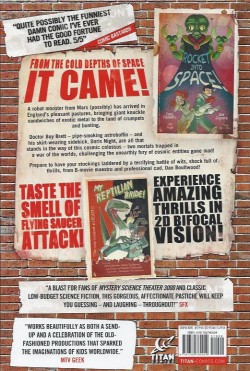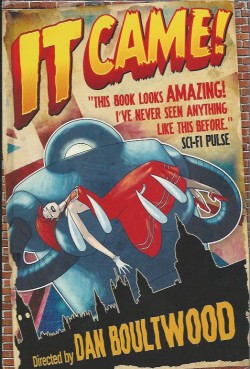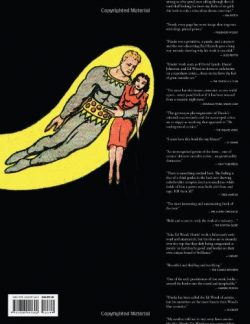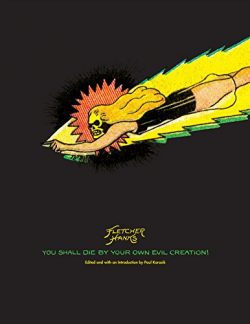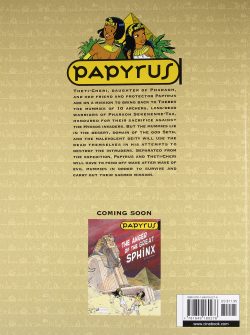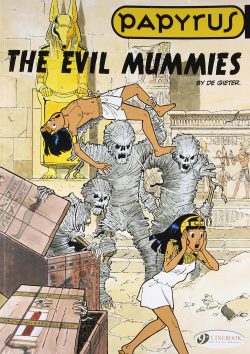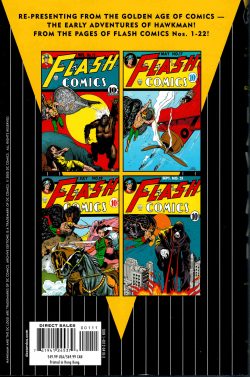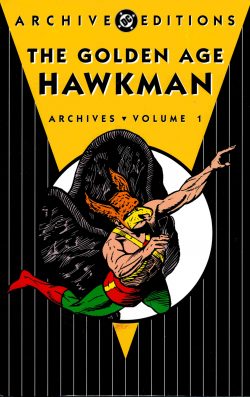

By Michael Cherkas & Larry Hancock, with Paul McCusker (NBM)
ISBN: 978-1-68112-255-7 (TPB)
During the vast expansion of opportunity and outpouring of innovation that graced comics during the 1980s, much of the “brain-rotting trash†or “silly kid’s stuff†stigma which had plagued the medium was finally dispelled. America started catching up to the rest of the world; acknowledging sequential narrative as an actual Capital “A†Art Form, and their doors opened wide open for foreigners to make a few waves too…
One of the most critically acclaimed and indescribably intoxicating features of the period came from semi-Canadian outfit Renegade Press which set up shop in the USA and began publishing at the very start of the black & white comics bubble in 1984. They quickly established a reputation for excellence, with a strong line of creator-based properties and some genuinely remarkable series such as Ms. Tree, Journey: The Adventures of Wolverine MacAlistaire, Flaming Carrot,Normalman, and the compulsively backwards-looking Cold War/UFO/paranoia-driven delight seen here: The Silent Invasion.
That last was a stunningly stylish conspiracy saga, bolting 1950s domestic terrors (invasion by Reds; invasion by aliens; invasion by new ideas…) onto Film Noir chic and employing 20-20 hindsight to produce a phenomenally fresh and enticing delight for the strangely similar Reagan era. From here and now, it’s never seemed more distressingly likely that politics, if not all history, is cursed to repeat certain cycles and strategies…
The series was eventually collected as four superbly oversized monochrome tomes (a whopping 298 x 2058 mm), re-presenting the lead story from the first dozen issues of The Silent Invasion wherein inspired co-creators Michael Cherkas & Larry Hancock concocted a delightful confection combining all the coolest genre elements of classic cult sci-fi, horror, spy, conspiracy theory, crime, romance and even comedy yarns…
Now, after far too long a wait – and with America once again enduring internecine struggle amongst the citizenry, corruption (but no collusion!!), cover-ups at every level of government and the press under attack from the people and traditions it seeks to inform and safeguard – the series has been remastered, marginally revised and re-released in a more manageable paperback size (or fully adjustable eBook format) with the express intention of catching up and finally completing the tensely compelling epic.
Third outing Abductions! gathers the moodily monochrome Sixties-set follow-up first seen in a manner both Byzantine and fitting. In May 1998, Indy heavyweight Caliber began The Silent Invasion: Abductions but the miniseries folded after one issue, only to be picked up by NBM in 2001 and successfully released as 5-issue sequence Secret Messagescourtesy of Cherkas, Hancock and auxiliary artist Paul McCusker. It ran from May 2001 to May 2002, presumably despite the best efforts of Greys, Lizards or Deep Government interventions…
The truth out here continues after an informative and coolly appraising Introduction ‘Here We Go Again’, from novelist Robert J. Sawyer (FlashForward, The Oppenheimer Alternative). However, before all that…
The 1950s in American were a hugely iconic and paradoxical time. Incomparable scientific and cultural advancements, great wealth and desperate, intoxicating optimism inexplicably arose amidst an atmosphere of immense social, cultural, racial, sexual and political repression with an increasingly paranoid populace seeing conspiracy and subversive attacks in every shadow and corner of the rest of the world.
Such an insular melting pot couldn’t help but be fertile soil for imaginative outsiders to craft truly incisive and evocative tales dripping with convoluted mystery and taut tension, especially when wedded to the nation’s fantastic – and then-ongoing – obsessions with rogue science, flying saucers, gangsterism and espionage…
They were also obsessed with hot babes and bust sizes, but more of that elsewhere…
What Has Gone Before: In April 1952, notorious Union City private eye Dick Mallet saw a strange light in the night sky. Next morning the cops found his empty, crashed automobile. A month later reporter Matt Sinkage was still getting grief from Frank Costello, Editor of the Union City Sentinel. Matt was frantic to expose “The Truth behind Flying Saucers†but quickly became an ostracised laughing stock, especially since he also suspected his foreign-sounding neighbour Ivan Kalashnikov was a Russian spy….
Sinkage alienated his family and drove his fiancée Peggy Black to distraction. All he could think about was a night six months previously in Albany when he witnessed a UFO and impetuously chased after it: a crazy night everyone remembers… except him.
When Matt broke into Ivan’s apartment, he saw the foreigner and others in front of a huge, weird machine. It confirmed his suspicions that they were Atomic spies. Days later, Matt collided with Mr K’s pretty friend Gloria Amber and cunningly asked her out to lunch. Things developed and Gloria begged him to save her from what she claimed were Red agents even though the thugs subsequently claimed to be Federal agents…
Hiding out at his brother Walter‘s place, Matt was still seeing flying saucers everywhere and couldn’t understand why everybody else thought they were just jets. In Union City, Frank was pressured by brutish FBI Agent Phil Housley: an old acquaintance who regularly forced him to suppress unwelcome or troubling news items…
This time he wanted Sinkage. What no newsman knew was that Housley was also working for a shadowy agency calling itself The Council. What Housley didn’t know was that he was only a pawn…
Back in suburbia, Walter’s wife Katie – convinced Matt and his new floozy Gloria were up to no good – reached out to the FBI. The fugitives were heading out in Walter’s car when Peggy showed up. She couldn’t understand why her man was with a flashy trollop, and wouldn’t accept that Matt only wanted the lowdown on the Reds and access to Kalashnikov’s memoirs and files. Matt knew Gloria was playing a double game, but agreed to go with to a remote town where a “contact†could protect them both…
Mr K called in his own heavies to hunt them, all factions equally unaware that the FBI had visited Katie and a net was closing around Sinkage and his mystery woman…
When the Council learn Sinkage was involved in the “Albany eventâ€, near-panic ensued. Matt eventually succumbed to suspicion. Gloria kept vanishing and refused to acknowledge it. and Kalashnikov’s hoods Zanini and Koldst abduct her and rough up Matt.
Events spiralled and came to a head in sleepy Stubbinsville. Housley and the FBI tracked the runaways and met up with the Reds and what might well have been aliens in the isolated region. The net closed around them as a fantastic and terrifying light-show ignited the dark skies. By the time the G-Men reached them, Gloria had vanished and Sinkage was in a coma. Days later, Matt was freed and all charges dropped. He was strangely content. Despite another blatant cover-up and no clue as to whom all the various parties hounding them really were, Sinkage knew what he had seen when Gloria vanished. Now he could only wait for her inevitable return…
Three years later, in September 1955, Sinkage was still waiting. He had spent much of that time in an asylum. On release, he moved to bucolic Rockhaven and resumed his old trade as a journalist. The uncaring outsider had tentatively established himself in the small town, but his job at The Ranger paid a pittance and offered no satisfaction. Sinkage earns extra cash writing fake news for spurious tabloid The Tattler.
His life spirals again after a proposed piece on cattle mutilations leads to a quasi-religious space cult in his own backyard. At first journalistic sight, the Sirian Utopia Foundation is a long con gulling wealthy widow Gladys Tanner. She devoutly believes the world is heading for imminent Armageddon and that her new gurus are in contact with a benign cosmic council promising enlightenment and global paradise …and they can also reunite her with her departed husband…
Her followers include many prominent Washington politicians and Sinkage’s research connects them to a bunch of missing scientists. That’s when Housley turns up, acting all buddy-buddy. Matt lapses into his old suspicions and starts snooping, “discovering†– after many tribulations and threats – that an extremely unconvincing fake flying saucer in the Tanner barn is a prop disguising the real thing…
The Council’s top thug Brennan resurfaces, spouting drivel about a commie conspiracy at the Tanner farm. Sinkage even thinks long-gone Kalashnikov has returned, but once again, drastic action by the Feds seemingly ends the investigation. Sinkage is now convinced of what’s really going on: America and the world are in the midst of a sly alien conquest and only he can expose it.
His first move is to join his recently at-liberty nemesis in Housely Investigations back in Union City, even though it means moving back in with Walter and his despicable sister-in-law Katie. By May 1958, Sinkage has become a phantom celebrity, a flying saucer freak and UFOlogist regularly cited by the media, but seldom seen. He warns of invasion and stalks political rising star and Presidential hopeful Senator Harrison T. Callahan – a candidate he believes to be mind-controlled by the invaders.
By 1959, Sinkage is an anonymous star on television, stridently declaring how aliens seize minds and program brains. His campaign against Callahan continues unabated. When the Senator decides to end to harassment, The Council re-enter the life of long-sidelined Phil Housley, proclaiming the alien issue is a Soviet plot to destabilise the USA. Over Walter’s most strenuous objections Katie manoeuvres to get Sinkage back into the asylum and he disappears from their lives…
In August, Callahan officially announces his candidacy and Sinkage makes a last desperate move, determined to preserve humanity at all costs…
In volume three (available in monochrome trade paperback and digital formats), the spotlight settles on Housley as ‘A Good Lawyer is Hard to Find’ sees the grizzled world-weary Private Eye basking in old glory in September 1965.
Nobody really cares anymore how he saved the life of America’s next president in August 1959, or that he had to kill a crazy reporter to do it. Now Housley’s life is all about making ends meet, accommodating his estranged wife Vivian while still seeing his kids, and keeping secretary/girlfriend Meredith Baxter from shouting at him. Union City, meanwhile, is reeling from a string of bizarre serial killings…
With life constantly kicking him hard, Phil finds an unexpected upside when glamourous new client Sarah Finster hires him to find her missing husband. She’s something of a maneater, exceedingly generous and will do literally anything to locate her innocuous spouse Howard…
The missing man is an attorney at prestigious Phelps, Finster and Phelan: Simultaneously simple and uncomplicated, his only character quirk is that he suffers blackouts: disappearing for days at a time and reappearing with no knowledge of where he’s been or that any time has passed. That’s when Housley really starts paying attention. After all, he’s been experiencing exactly the same problems lately…
Finster had been seeing a shrink about the problem, a doctor named Jeffrey Plunck, but before tracking him down Phil interviews the employers and learns more than he bargained for. They reveal that not only had Howard been disappearing and experiencing memory problems for more than a year, he also claimed to have been abducted by aliens…
The mystery deepens in ‘Ghosts are Hard to Bury’ as Housley contacts creepily officious Dr. Plunck and is stonewalled in a manner he thought only Feds could pull off. Heading home to Meredith, he falls asleep in front of new TV sensation Canadian Football and has a chilling dream about Matt Sinkage, the madman he killed to save current US President Callahan…
When an envelope arrives, containing a note to meet and a recent photo of a number of people including Plunck and the impossibly still-alive Sinkage, Phil dashes off to a seedy club and meets Nora Marsh: Howard’s probable girl on the side and another regular alien abductee.
He has no idea he’s being shadowed until he’s ambushed. When he regains consciousness, Nora is gone but she’s left a list of names which lead to the missing Howard. Bringing the bemused and bewildered lawyer home, Phil is suddenly blasted by blazing light and awakens having lost more time… and memories…
‘Canadian, Eh’ opens with dazed and confused Phil revisiting all he knows about Sinkage and confronting the reporter’s former boss Frank Costello. He learns the paper Nora gave him lists people who have recently died or been murdered in uncanny circumstances. Walter Sinkage then adds fuel to the insane alien nonsense by expounding a raft of crazy suppositions about Canada’s Flying Saucer programme – and their football exploits – leaving Housley more baffled than ever and blithely unaware of how many different people have him under observation.
And that’s when the bodies start piling up and circumstantially pointing to Phil, his increasingly troubled homelife and those oh-so-convenient memory black-outs…
As witnesses and potential allies vanish or die, and with a procedural net he’s very used to holding now closing around him, Phil goes into overdrive in ‘The Lost and the Found’. On the run but uncharacteristically determined to find answers, Housley raids Dr. Plunck’s office, stumbling upon an incredible secret (more than one, in fact), provoking a massive and deadly response from his hidden foes, and precipitating a savage and chaotic clash with the resurgent forces of The Council and the irresistible powers behind them in chilling conclusion ‘Falling into the Light’…
To Be Concluded…
Gripping and utterly addictive, The Silent Invasion is a uniquely beguiling confection rendered in a compelling, spectacularly expressionistic style: an epic that perpetually twists and turns, leaving readers dazed, dazzled and always hungry for more. Tragically, its warped Machiavellian shenanigans have never been more relevant than now and lead me to conclude that the infiltration is complete and that weird inexplicable non-humans already stalk all earthly corridors of power…
Abductions! offers an unforgettable gateway to an eerily familiar yet comfortably exotic era of innocent joy and a million “top secrets†which no fan of fantastic thriller fiction should ignore and the best is still to come…
© 1998, 1999, 2001, 2002, 2012 and 2020 Michael Cherkas & Larry Hancock. All rights reserved.
Most NBM books are also available in digital formats. For more information and other great reads see http://www.nbmpub.com/




